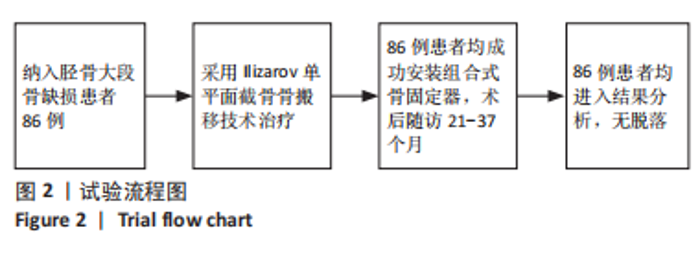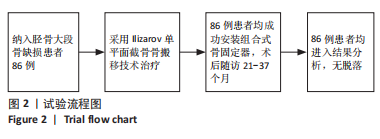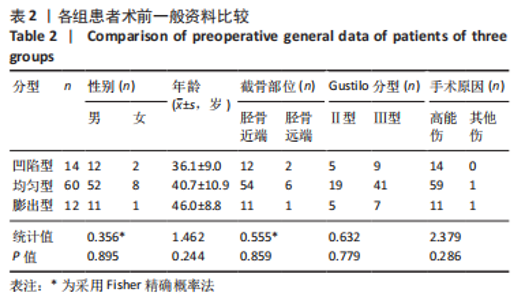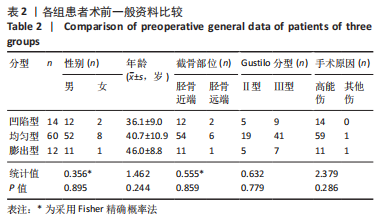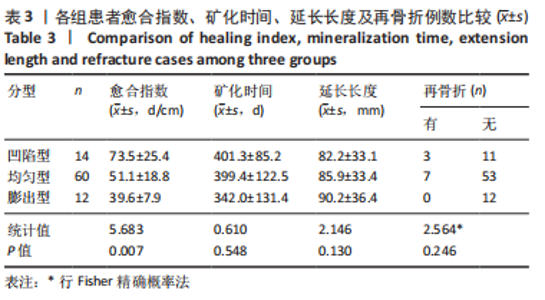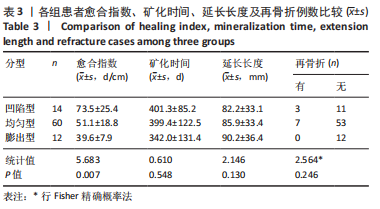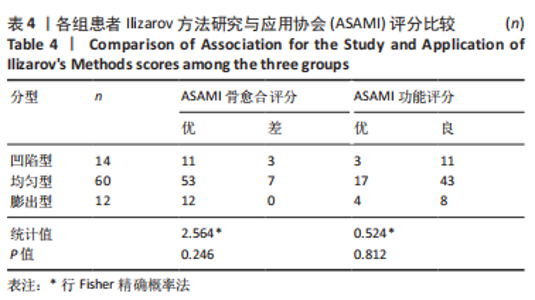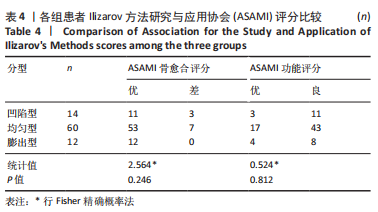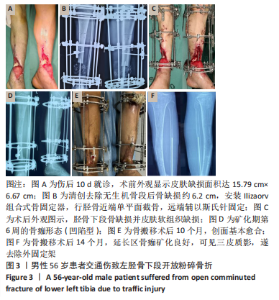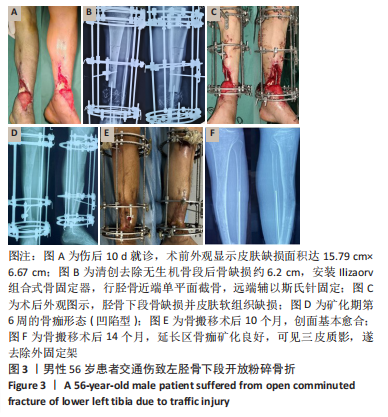[1] SALA F, THABET AM, CASTELLI F, et al. Bone transport for postinfectious segmental tibial bone defects with a combined ilizarov/taylor spatial frame technique. J Orthop Trauma. 2011;25(3):162-168.
[2] MIFSUD M, FERGUSON JY, STUBBS DA, et al. Simultaneous debridement, Ilizarov reconstruction and free muscle flaps in the management of complex tibial infection. J Bone Jt Infect. 2020;6(3):63-72.
[3] FÜRMETZ J, SOO C, BEHRENDT W, et al. Bone Transport for Limb Reconstruction Following Severe Tibial Fractures. Orthop Rev (Pavia). 2016;8(1):6384.
[4] FISCHGRUND J, PALEY D, SUTER C. Variables affecting time to bone healing during limb lengthening. Clin Orthop Relat Res. 1994;(301): 31-37.
[5] DONG S, HUANG D, ZHU L, et al. Treatment of diabetic foot with vaccum sealing drainage combined with transverse tibial bone transport. Zhongguo Xiu Fu Chong Jian Wai Ke Za Zhi. 2020;34(7): 869-873.
[6] 吕梓宸, 王斌, 高顺红, 等. 三种截骨方式对胫骨骨搬移术愈合的影响分析[J]. 中华创伤骨科杂志,2022,24(4):339-344.
[7] DAVDA K, HEIDARI N, CALDER P, et al. ‘Rail and Nail’ bifocal management of atrophic femoral nonunion. Bone Joint J. 2018;100-b(5):634-639.
[8] LAMBIRIS E, PAPADOPOULOS A, KARABASI A, et al. Secondary intramedullary nailing after distraction osteogenesis: 30 patients followed for 2-12 years. Acta Orthop Scand. 2004;75(4):481-486.
[9] HAMITI Y, YUSHAN M, YALIKUN A, et al. Matched comparative study of trifocal bone transport versus induced membrane followed by trifocal bone transport in the treatment of segmental tibial defects caused by posttraumatic osteomyelitis. BMC Musculoskelet Disord. 2022;23(1): 572.
[10] BORZUNOV DY. Long bone reconstruction using multilevel lengthening of bone defect fragments. Int Orthop. 2012;36(8):1695-1700.
[11] PALEY D, MAAR DC. Ilizarov bone transport treatment for tibial defects. J Orthop Trauma. 2000;14(2):76-85.
[12] ILIZAROV GA. The tension-stress effect on the genesis and growth of tissues. Part I. The influence of stability of fixation and soft-tissue preservation. Clin Orthop Relat Res. 1989;(238):249-281.
[13] ILIZAROV GA. The tension-stress effect on the genesis and growth of tissues: Part II. The influence of the rate and frequency of distraction. Clin Orthop Relat Res. 1989;(239):263-285.
[14] 程康, 王斌, 涂振兴,等. 双平面截骨骨搬运联合髓内钉治疗胫骨大段骨缺损[J]. 中国组织工程研究,2023,27(13):2058-2063.
[15] ROBERT ROZBRUCH S, WEITZMAN AM, TRACEY WATSON J, et al. Simultaneous treatment of tibial bone and soft-tissue defects with the Ilizarov method. J Orthop Trauma. 2006;20(3):197-205.
[16] 康庆林, 孔令驰, 李刚. Ilizarov技术基础研究进展[J]. 中华骨科杂志, 2021,41(11):714-719.
[17] 徐永清, 朱跃良, 林玮, 等. 胫骨截骨骨搬移治疗胫骨大段感染性骨缺损伴软组织缺损[J]. 中华创伤骨科杂志,2018,20(8):666-670.
[18] 王斌, 宫中平, 刘英杰, 等. 腓骨横向骨搬移微血管网再生术治疗糖尿病足[J]. 中华医学杂志,2020,100(9):710-712.
[19] WANG B, ZHANG X, HUO Y, et al. Calcaneal lengthening for partial traumatic loss of the calcaneus. Injury. 2019;50(3):796-803.
[20] BOWEN JR, LEVY EJ, DONOHUE M. Comparison of knee motion and callus formation in femoral lengthening with the Wagner or monolateral-ring device. J Pediatr Orthop. 1993;13(4):467-472.
[21] HAMANISHI C, YASUWAKI Y, KIKUCHI H, et al. Classification of the callus in limb lengthening. Radiographic study of 35 limbs. Acta Orthop Scand. 1992;63(4):430-433.
[22] AQUERRETA JD, FORRIOL F, CAÑADELL J. Complications of bone lengthening. Int Orthop. 1994;18(5):299-303.
[23] LI R, SALEH M, YANG L, et al. Radiographic classification of osteogenesis during bone distraction. J Orthop Res. 2006;24(3):339-347.
[24] BAUMGART R, SCHUSTER B, BAUMGART T. Callus distraction and bone transport in the treatment of bone defects. Orthopade. 2017;46(8): 673-680.
[25] ARONSON J, GOOD B, STEWART C, et al. Preliminary studies of mineralization during distraction osteogenesis. Clin Orthop Relat Res. 1990;(250):43-49.
[26] KORZINEK K, TEPIC S, PERREN SM. Limb lengthening and three-dimensional deformity corrections. A retrospective clinical study. Arch Orthop Trauma Surg. 1990;109(6):334-340.
[27] MOORE DC, LEBLANC CW, MÜLLER R, et al. Physiologic weight-bearing increases new vessel formation during distraction osteogenesis: a micro-tomographic imaging study. J Orthop Res. 2003;21(3):489-496.
[28] WANG B, ZHANG G, YANG H, et al. Comparison of accordion maneuver with compression technique alone for the treatment of atrophic fracture nonunion: A rabbit model. Acta Orthop Traumatol Turc. 2021; 55(5):377-384.
[29] XU J, SUN Y, WU T, et al. Enhancement of bone regeneration with the accordion technique via HIF-1α/VEGF activation in a rat distraction osteogenesis model. J Tissue Eng Regen Med. 2018;12(2): e1268-e1276.
[30] TEPPER OM, CALLAGHAN MJ, CHANG EI, et al. Electromagnetic fields increase in vitro and in vivo angiogenesis through endothelial release of FGF-2. FASEB J. 2004;18(11):1231-1233.
[31] WANG X, ZHU S, JIANG X, et al. Systemic administration of lithium improves distracted bone regeneration in rats. Calcif Tissue Int. 2015; 96(6):534-540.
[32] LITTLE DG, SMITH NC, WILLIAMS PR, et al. Zoledronic acid prevents osteopenia and increases bone strength in a rabbit model of distraction osteogenesis. J Bone Miner Res. 2003;18(7):1300130-1300137.
[33] HAO J, CHOU J, KURODA S, et al. Injectable simvastatin gel for minimally invasive periosteal distraction: In vitro and in vivo studies in rat. Clin Oral Implants Res. 2018;29(2):227-234.
[34] ] JIA Y, ZHU Y, QIU S, et al. Exosomes secreted by endothelial progenitor cells accelerate bone regeneration during distraction osteogenesis by stimulating angiogenesis. Stem Cell Res Ther. 2019;10(1):12.
[35] CAO J, WANG L, DU ZJ, et al. Recruitment of exogenous mesenchymal stem cells in mandibular distraction osteogenesis by the stromal cell-derived factor-1/chemokine receptor-4 pathway in rats. Br J Oral Maxillofac Surg. 2013;51(8):937-941.
[36] YANG Y, PAN Q, ZOU K, et al. Administration of allogeneic mesenchymal stem cells in lengthening phase accelerates early bone consolidation in rat distraction osteogenesis model. Stem Cell Res Ther. 2020;11(1): 129.
[37] ALEKSYNIENE R, THOMSEN JS, ECKARDT H, et al. Parathyroid hormone PTH(1-34) increases the volume, mineral content, and mechanical properties of regenerated mineralizing tissue after distraction osteogenesis in rabbits. Acta Orthop. 2009;80(6):716-723.
[38] LEE DH, RYU KJ, KIM JW, et al. Bone marrow aspirate concentrate and platelet-rich plasma enhanced bone healing in distraction osteogenesis of the tibia. Clin Orthop Relat Res. 2014;472(12):3789-3797. |
